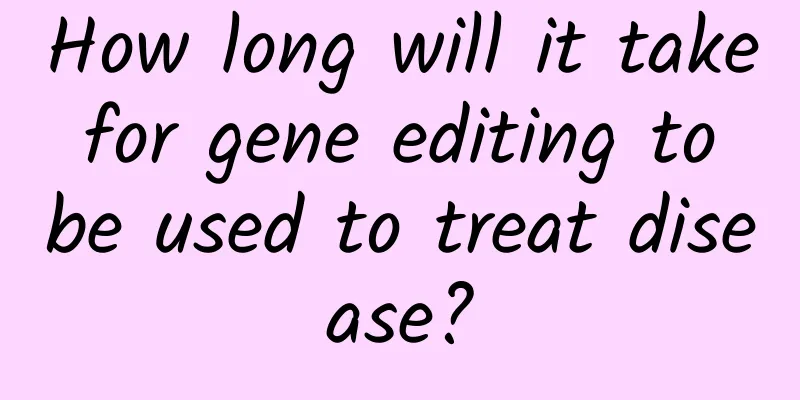How long will it take for gene editing to be used to treat disease?

|
Technology changes life, and the future life that could only be seen in movies before is gradually being realized. A friend asked, at this stage of rapid development of global high-tech cutting-edge technologies, which cutting-edge technologies are most worthy of our attention, and which ones are closely related to us? When it comes to cutting-edge technology, such as the Tiangong Dream, the artificial sun, etc., these are all very high-end. But when it comes to things that are closely related to life, I want to say a little about my views on life medicine: I am optimistic about the clinical application of gene editing for the treatment of diseases. I personally think this may be one of the most easily approved clinical applications because of the precedent of CAR-T (although CAR-T is also gene editing, it is slightly different from the gene editing in the context of common usage). But it is not as easy as everyone thinks. Why? Many people always think that life science and medical research is easy. If a technology is just released today, they think it can be applied in a few years. In fact, this greatly overestimates the complexity of reality. For example, the application of gene editing technology currently requires solving at least the following problems. Let me introduce them to you one by one. 01. Problems with the technology itself Many laymen would think that gene editing technology is very mature, from ten years ago to now, and even won the Nobel Prize in the past two years. But in fact, gene editing technology has been improving all the time. Even the editing efficiency problem that many people think is also improving. For example, in the past two years, the PE system that Liu Ruqian has been committed to developing has gone from PE2 to PE5, and he also published a cell paper in November last year. Every time you look at the official account, you will feel that it is perfect, but in fact, there are always problems. For example, the DdCBE system developed by Liu Ruqian in 2020 can achieve precise gene editing, which was also a major paper in Nature at the time. There were several follow-up studies at the time, which found that it was indeed effective. However, this year, another paper found that DdCBE produced a large number of genome-wide SNV off-target effects on nuclear DNA. It can be said that the current gene editing system is still some distance away from maturity, and we need to continue to work on this system. 02. Real research issues This problem is even more time-consuming. I believe that many people have learned about the vaccine development process through the new crown. If gene editing wants to be clinically applied, it must go through the same process. The first step is to repeatedly verify the cells to prove their feasibility. Next, animal experiments are carried out. Mice are the basic ones, and monkeys may be used if conditions permit. This step is counted in years. Further down, there are clinical trials. After three phases, this time is the minimum of 5 years. After the above research is basically completed, it can be officially approved for application. During this period, if any step goes wrong, the process may stop. 03. Approval Agency Conducting medical research requires approval from relevant agencies. For example, the FDA has previously suspended clinical trials of CAR-T based on gene editing. The reason is that a patient was found in the clinic that after using gene editing drugs, all blood cell lines in his body were reduced, and cells with abnormal chromosomes appeared, increasing the risk of cancer. So the FDA just suspended it. 04. Who is it for? What disease is it for? This is even more complicated. Currently, the most common human cell therapy is cancer, which is the familiar CAR-T, which costs 1.2 million per injection, but it is mainly used for non-solid tumors. The advantage is that it has been clinically approved, so there will be fewer obstacles to its use. The second is probably rare diseases. However, there are some specific problems with rare diseases. For example, it is still very difficult to identify single gene rare diseases. In short, I personally believe that cutting-edge technology such as gene editing is very likely to enter clinical applications in the next ten to twenty years. |
Recommend
The stronger the immune system, the better? Not necessarily! Be careful of this "immortal cancer"!
Not long ago, #13-year-old girl suffers from lupu...
[2014 WOT Shenzhen Station Lecturer Interview] Tencent Zhang Dan: Mobile games will be further segmented
From November 21 to 22, 2014, the 2014 WOT Global...
Case Analysis|Review of Himalaya FM's "66 Membership Day" event
1. Activity Background 1. Market conditions Pay a...
Short videos put an end to the era of unlicensed operation. The industry under supervision must exercise self-discipline
Recently, the State Administration of Radio, Film ...
Olympic champion Zheng Qinwen insists on eating chicken breast and broccoli for 360 days. Can ordinary people do the same?
Review expert: Peng Guoqiu, deputy chief physicia...
Can 5G extend the life of HTC’s desperate VR business?
5G is like a "tonic pill" that has sudd...
The most comprehensive inventory of online traffic promotion tools
Nowadays, marketing is basically online marketing...
Going Alpha: "Decoding Attraction" reveals the essence of relationships between men and women
Going Alpha "Decoding Attraction" revea...
Mr. Crab: The Secret of How to Play Taobao on Douyin Live Broadcast
Introduction Official accounts 5 years ago, Wecha...
Let’s talk about user churn analysis in the simplest way
Churn analysis is not about analyzing the problem...
Tesla's first general manager in China, Zheng Shunjing, passed away, the cause has not yet been announced
On the afternoon of January 17, Tesla’s first gen...
Say goodbye to injections! Is oral semaglutide better?
Recently, semaglutide, known as the "magic d...
The principle and solution of foam formation
Foam is a common phenomenon. Generally speaking, ...
ENISA: 2023 AI and Standardized Cybersecurity Report
ENISA has published the "Cybersecurity Repor...
How to write good information flow copywriting ideas? 5 creative ideas to help you get inspiration quickly!
Due to the particularity of information flow adve...









